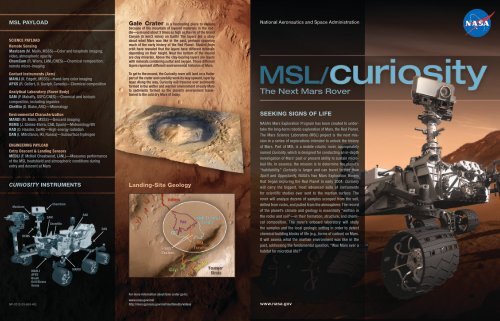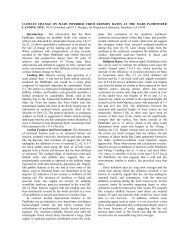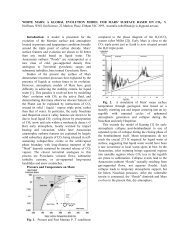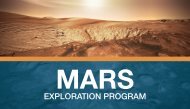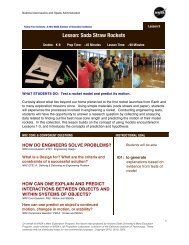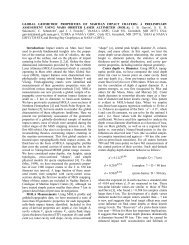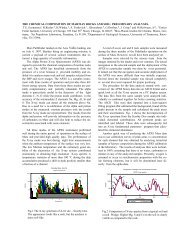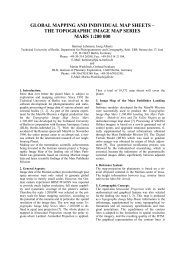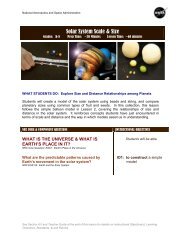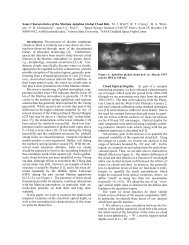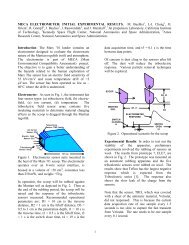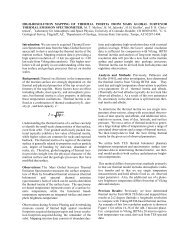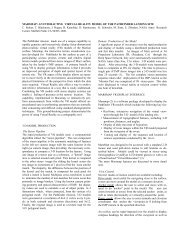Curiosity's Brochure - Mars Exploration Program - NASA
Curiosity's Brochure - Mars Exploration Program - NASA
Curiosity's Brochure - Mars Exploration Program - NASA
Create successful ePaper yourself
Turn your PDF publications into a flip-book with our unique Google optimized e-Paper software.
MSL PAYLOAD<br />
SCIENCE PAYLOAD<br />
Remote Sensing<br />
Mastcam (M. Malin, MSSS)—Color and telephoto imaging,<br />
video, atmospheric opacity<br />
ChemCam (R. Wiens, LANL/CNES)—Chemical composition;<br />
remote micro-imaging<br />
Contact Instruments (Arm)<br />
MAHLI (K. Edgett, MSSS)—Hand-lens color imaging<br />
APXS (R. Gellert, U. Guelph, Canada)—Chemical composition<br />
Analytical Laboratory (Rover Body)<br />
SAM (P. Mahaffy, GSFC/CNES)—Chemical and isotopic<br />
composition, including organics<br />
CheMin (D. Blake, ARC)—Mineralogy<br />
Environmental Characterization<br />
MARDI (M. Malin, MSSS)—Descent imaging<br />
REMS (J. Gómez-Elvira, CAB, Spain)—Meteorology/UV<br />
RAD (D. Hassler, SwRI)—High-energy radiation<br />
DAN (I. Mitrofanov, IKI, Russia)—Subsurface hydrogen<br />
ENGINEERING PAYLOAD<br />
Entry Descent & Landing Sensors<br />
MEDLI (F. McNeil Cheatwood, LANL)—Measures performance<br />
of the MSL heatshield and atmospheric conditions during<br />
entry and descent at <strong>Mars</strong><br />
CURIOSITY INSTRUMENTS<br />
Mastcam<br />
REMS<br />
NP-2012-03-850-HQ<br />
MAHLI<br />
APXS<br />
Brush<br />
Drill/Sieves<br />
Scoop<br />
SAM<br />
ChemCam<br />
ChemMin<br />
MARDI<br />
RAD<br />
DAN<br />
Gale Crater is a fascinating place to explore<br />
because of the mountain of layered materials in the middle—a<br />
mound about 3 times as high as the rim of the Grand<br />
Canyon (5 km/3 miles) on Earth! The layers tell a story<br />
about what <strong>Mars</strong> was like in the past, perhaps spanning<br />
much of the early history of the Red Planet. Studies from<br />
orbit have revealed that the layers have different minerals<br />
depending on their height. Near the bottom of the mound<br />
are clay minerals. Above the clay-bearing layers are layers<br />
with minerals containing sulfur and oxygen. These different<br />
layers represent different environmental histories of <strong>Mars</strong>.<br />
To get to the mound, the Curiosity rover will land on a flatter<br />
part of the crater and carefully work its way upward, layer by<br />
layer. Along the way, Curiosity will traverse over sediments<br />
formed in the wetter and warmer environment of early <strong>Mars</strong><br />
to sediments formed as the planet’s environment transitioned<br />
to the cold dry <strong>Mars</strong> of today.<br />
Landing-Site Geology<br />
For more information about Gale crater go to:<br />
www.nasa.gov/msl<br />
http://mars.jpl.nasa.gov/msl/multimedia/videos<br />
National Aeronautics and Space Administration<br />
The Next <strong>Mars</strong> Rover<br />
SEEKING SIGNS OF LIFE<br />
<strong>NASA</strong>’s <strong>Mars</strong> <strong>Exploration</strong> <strong>Program</strong> has been created to undertake<br />
the long-term robotic exploration of <strong>Mars</strong>, the Red Planet.<br />
The <strong>Mars</strong> Science Laboratory (MSL) project is the next mission<br />
in a series of explorations intended to unlock the history<br />
of <strong>Mars</strong>. Part of MSL is a mobile robotic rover, appropriately<br />
named Curiosity, which is designed for conducting an in-depth<br />
investigation of <strong>Mars</strong>’ past or present ability to sustain microbial<br />
life. In essence, the mission is to determine the planet’s<br />
“habitability.” Curiosity is larger and can travel farther than<br />
Spirit and Opportunity, <strong>NASA</strong>’s two <strong>Mars</strong> <strong>Exploration</strong> Rovers<br />
that began exploring the Red Planet in early 2004. Curiosity<br />
will carry the biggest, most advanced suite of instruments<br />
for scientific studies ever sent to the martian surface. The<br />
rover will analyze dozens of samples scooped from the soil,<br />
drilled from rocks, and pulled from the atmosphere. The record<br />
of the planet’s climate and geology is essentially “written in<br />
the rocks and soil”—in their formation, structure, and chemical<br />
composition. The rover’s onboard laboratory will study<br />
the samples and the local geologic setting in order to detect<br />
chemical building blocks of life (e.g., forms of carbon) on <strong>Mars</strong>.<br />
It will assess what the martian environment was like in the<br />
past, addressing the fundamental question, “Was <strong>Mars</strong> ever a<br />
habitat for microbial life?”<br />
www.nasa.gov
Entry Interface<br />
Peak Heating<br />
Peak Deceleration<br />
THE ARRIVAL<br />
Hypersonic<br />
Aeromaneuvering<br />
The MSL spacecraft will make a dramatic entry into the martian<br />
atmosphere and then descend on a parachute. Next, a descent<br />
stage carrying Curiosity will drop away and slow itself further<br />
with small rocket engines. Hovering just above the <strong>Mars</strong> surface,<br />
the descent stage will become a “sky crane” as it lowers<br />
the rover on a tether to the surface, where Curiosity will land<br />
on its wheels. On the surface, the rover will be able to drive<br />
over obstacles up to 75 centimeters (29 inches) high and travel<br />
up to 140 meters (475 feet) per hour. On average, Curiosity is<br />
expected to travel about 200 meters (656 feet) per driving day,<br />
depending on power levels, slippage, steepness of the terrain,<br />
visibility, and the engineering tasks and science investigations<br />
that it may be assigned.<br />
Arriving at <strong>Mars</strong> in August 2012, MSL will serve as a beginning<br />
towards the next decade of <strong>Mars</strong> exploration, representing a<br />
huge step in <strong>Mars</strong> surface science and exploration capability by:<br />
• Demonstrating the ability to land a metric-ton-class rover<br />
on the surface of <strong>Mars</strong>.<br />
• Demonstrating the ability to land much more precisely than<br />
previous missions.<br />
• Demonstrating long-range mobility for collection of more<br />
diverse samples and performing a wider array of studies.<br />
• Demonstrating reliable, long-lived power systems<br />
necessary for future missions exposed to the extreme<br />
environments of space and planetary surfaces.<br />
Parachute Deploy<br />
Heatshield Separation<br />
Entry, Descent, and Landing<br />
Radar Data Collection<br />
Backshell Separation<br />
Sky Crane represents the use of a new<br />
“soft-landing” technique employed at <strong>Mars</strong>. The<br />
sheer mass of MSL prevents engineers from using<br />
the familiar airbags to deliver their rover safely to the<br />
martian surface. When the vehicle has been slowed to<br />
nearly zero velocity, the rover will be released from the<br />
descent stage. A bridle and “umbilical cord” will lower<br />
the rover to the ground. When the on-board computer<br />
senses that touchdown is successful, it will cut the<br />
bridle and fly away, leaving the rover on the surface.<br />
Sojourner<br />
Powered Descent<br />
Spirit &<br />
Opportunity<br />
Sky Crane<br />
Curiosity<br />
Rover Mass 10.5 kg 174 kg 950 kg<br />
Driving Distance (req’t/actual) 10 m/102 m 600 m/31.468 m 20,000 m/TBD<br />
Mission Duration* (req’t/actual) 10 sols/83 sols 90 sols/2886 sols †<br />
668 sols/TBD<br />
Power/Sol* 0.016 kWhr 0.499-0.590 kWhr ~2.5 kWhr<br />
Instruments/Mass 1/


